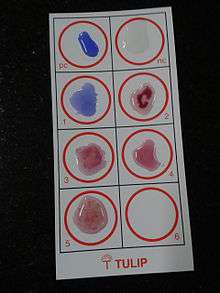Widal test

The Widal test, developed in 1896 and named after Georges-Fernand Widal, who introduced it, is a presumptive serological test for enteric fever or undulant fever whereby bacteria causing typhoid fever are mixed with a serum containing specific antibodies obtained from an infected individual. In cases of Salmonella infection, it is a demonstration of the presence of O-soma false-positive result. Test results need to be interpreted carefully to account for any history of enteric fever, typhoid vaccination, and the general level of antibodies in the populations in endemic areas of the world. Typhidot is the other test used to ascertain the diagnosis of typhoid fever. As with all serological tests, the rise in antibody levels needed to perform the diagnosis takes 7–14 days, which limits its applicability in early diagnosis. Other means of diagnosing Salmonella typhi (and paratyphi) include cultures of blood, urine and faeces. These organisms produce H2S from thiosulfate and can be identified easily on differential media such as Bismuth sulfite agar.
2-mercaptoethanol is often added to the Widal test. This agent more easily denatures the IgM class of antibodies, so if a decrease in the titer is seen after using this agent, it means that the contribution of IgM has been removed leaving the IgG component. This differentiation of antibody classes is important as it allows for the distinction of a recent (IgM) from an old infection (IgG).
The Widal test is positive if TO antigen titer is more than 1:160 in an active infection, or if TH antigen titer is more than 1:160 in past infection or in immunized persons. A single Widal test is of little clinical relevance due to the high number of cross-reacting infections, including malaria. If no other tests (either bacteriologic culture or more specific serology) are available, a fourfold increase in the titer (e.g., from 1:40 to 1:640) in the course of the infection, or a conversion from an IgM reaction to an IgG reaction of at least the same titer, would be consistent with a typhoid infection.
A new serological test called the Tubex test is not superior to the Widal test, and even the Widal test gives better performance results, so the Tubex test is not recommended for diagnosis of typhoid fever.[1]
See also
References
- ↑ "TUBEX Test Versus Widal Test In The Diagnosis Of Typhoid Fever In Kafr El -Shekh, Egypt.". Retrieved December 11, 2013.
External links
- Widal agglutination test - 100 years later: still plagued by controversy. Postgrad Med J 2000; 76(892): 80-4. PMID 10644383